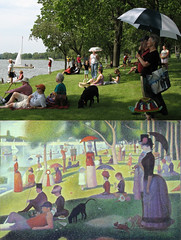Some of the most important pre-work I have ever done has been taking the StrengthFinder profile. Don Clifton, one of the founders of the Strength-based approach in psychology, came up with this “quiz” that helps you identify your areas of strengths and talent. Knowing my strengths helps me to emphasize what I’m good at, and find ways to compensate for my weaknesses in most projects I work on. This way, I avoid doing things I am not so good at accomplishing, outsource those things to people who are better at them day to day, and instead, work on what I do best.
This works 98% of the time, without fail. What is frustrating from time to time, is when your areas of strength cause friction with others. For example, I’m great with operational stuff- this is why Chris Penn and Chris Brogan made me Director of Operations for the Podcamp Foundation. I’m good at taking a big picture and making all the little parts work so the outcome meets the dream.
Sometimes, the big picture people hate to talk about the details- they just want it to happen. This can cause problems when the detail person asks for parameters on what the big idea person wants, because some of the choices make a big difference in how you structure the foundation of the plan or event.
For example, I worked with someone at one point who couldn’t decide how large an event they wanted, yet wanted lots of prices on what it would cost. I tried to give them a range of options, but in the end, the venue and expense associated with it is largely dependent on the number of people you expect- a meeting for 25 people is at one sort of venue; for 150 at another, and the cost per person is not always linear. You also don’t want to have to commit to feeding a large number of people on a per head cost if you don’t know, even ballpark, how many folks are going to show. These details can frustrate big picture people who just want the work done, yet without these pieces of information and discussing the options, how can I deliver on what they expect?
It’s a catch-22 situation that can be extremely frustrating. While I look at my skill set as making people’s dreams and ideas come true, making the vision a reality, sometimes I need less abstract impressionist and more cinema verite if you get my drift.
Maybe this is why I’ve always loved Seurat’s paintings. He makes an impressionistic painting where the mood of the whole is important, but up close, you see all the dots that comprise the whole. It’s the big picture and the details all in one. It’s a perfect balance of the big picture and small details all in one frame, telling multiple stories within one frame.
I’ve found striking this balance in real life challenging. How do you adequately balance the details and the big picture? If you have to change one, can you change everything underneath?
I tend to build events and projects like they are legos- one brick at a time, and each brick gets added as time and money allow. You start with the must haves and add the amenities as you can, until the whole thing comes together in the end, on budget, with all the have-to-haves met, and the extras added as available under constraints. This means I can be kind of rigid with managing all the threshold questions and issues up front, but it means the rest of the project comes together based on a strong foundation that ensures a base line level of success.
The idea of preparation and dealing with thorny issues up front can be really frustrating to the big picture people, who hate getting bogged down in details. The details pop their balloon and make them decide to go do something else. The idea is awesome, but the execution makes them tired and cranky.
Learning how to balance the details and the big picture is obviously something I am struggling with right now. Maybe I need to take more lessons from Seurat and realize the details are part of the big picture, but not the picture itself. It’s balancing the goal and the path to the goal that is ultimately important. This is the trick I need to further perfect- to keep the big picture and the big picture people concentrating on the outcome, and worry less about the details.
As you can see from the picture and the re-creation of Seurat’s painting as a photograph, there’s still a difference between reality and impressionism. The trick is figuring out how many rough edges you really need, and when is “in the ballpark” good enough. That’s what I need to learn.
If you have any advice at all to help me learn this skill, I would be most grateful. Is there a book you’ve read, a blog or podcast that’s helps teach this balance? Or is this experience-driven alone?
The crash of dreams and reality are not always pretty, but as we see in this picture, they can come awfully close.

